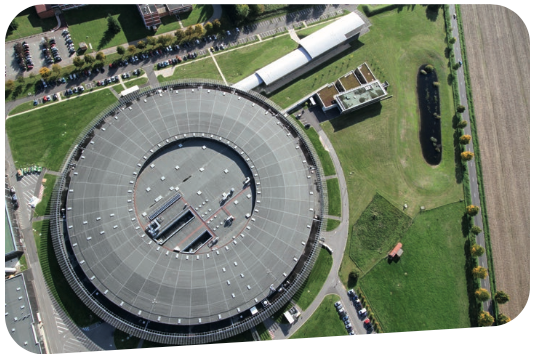This document, which you can download, presents the conceptual design of an upgrade of Synchrotron SOLEIL accelerators, beamlines and infrastructure. The project is planned in two phase of 5 years each, “construction” and “towards full performance”.
Twenty years after SOLEIL was established, science, and the role and breadth of a large scale infrastructure in scientific exploration have considerably evolved and widened. New scientific fields have emerged to which the facility needs to adapt. This sets the scientific case for this upgrade in the four areas which have been identified as key to meet the challenges our society is facing (advanced materials, sustainable energy, biology and health, earth and the environment): discovery of new quantum materials, use of Artificial Intelligence in materials or drug design, fight against new pathogens or dealing with new kinds of pollutants like nanoplastics are challenges where the upgraded SOLEIL has the ambition to have a decisive impact.

Addressing these challenges requires exploring heterogeneous and complex systems at the nanometer scale using complementary methods in order to understand their organization, properties and function. This will be made possible by reconstructing SOLEIL’s storage ring as a Diffraction Limited Storage Ring (DLSR). The original and ambitious design proposed here will produce round electron beams with a record low emittance of less than 50 pm.rad x 50 pm.rad, hence photon beams with an exceptional brilliance exceeding by two orders of magnitude those of the present facility. At the new facility:
- nanometric resolution will become the rule for most of the beamlines,
- the increase in brilliance, coherence and flux will allow one to follow biological processes or the functioning of devices operando at ms or sub-ms timescales,
- the detection limit of trace elements will be decreased by three orders of magnitude, with an extraordinary impact expected in environmental science.
The development of new, revolutionary methods like structured UV imaging, use of streak cameras to study ultrafast dynamics, in vivo crystallography or soft X-ray interferometry, is an integral part of the project.
Together with the accelerators upgrade, these developments will keep the competitiveness of SOLEIL and extend its lifetime by at least 15 years as most of the European facilities are undergoing similar upgrades. SOLEIL will be unique owing to the broad range of beam energies from THz to hard X-rays it delivers, which will be even further extended. Its domain of excellence continues to lie in the soft to tend X-ray range making it complementary to the ESRF-EBS. Thanks to this upgrade, an exceptionally broad range of techniques will be made available to the academic and industrial user communities, enabling truly integrative research opportunities which are at the heart of the upgrade vision.
Access modes will evolve in order to make the most efficient use of the upgraded facility in an open data perspective. This will be accompanied by an upgrade of information system which will be a data orientated transformative change benefiting all SOLEIL activities.
This upgrade shall also offer a fantastic opportunity to develop the human capital of SOLEIL and its stakeholders along all the lines already exemplified in the socio-economic study carried out concomitantly (a comprehensive report is in preparation, several aspects of this subject can be already found in chapter 9 of the CDR).
The upgraded facility will use the present storage ring tunnel and most of the present infrastructure in order to optimize the cost of the project. Replacement of the aging infrastructure after almost two decades of operation will allow a dramatic reduction in the facility environmental footprint, and the systematic use of permanent magnet for the storage ring will allow a reduction by one half of its electric power consumption, also significantly reducing operation cost.

The ambitious design which is proposed is accompanied by extensive prototyping in accelerator technology, insertions devices, vacuum system, optics, detectors, development of new experimental methods... Importantly, this development of innovative instrumentation will be leveraged from our partners of the League of European Accelerator-based Photon Sources (LEAPS), therefore reducing overall investment and its potential for technology transfer is already being explored.
We hope you enjoy reading this Conceptual Design report!
